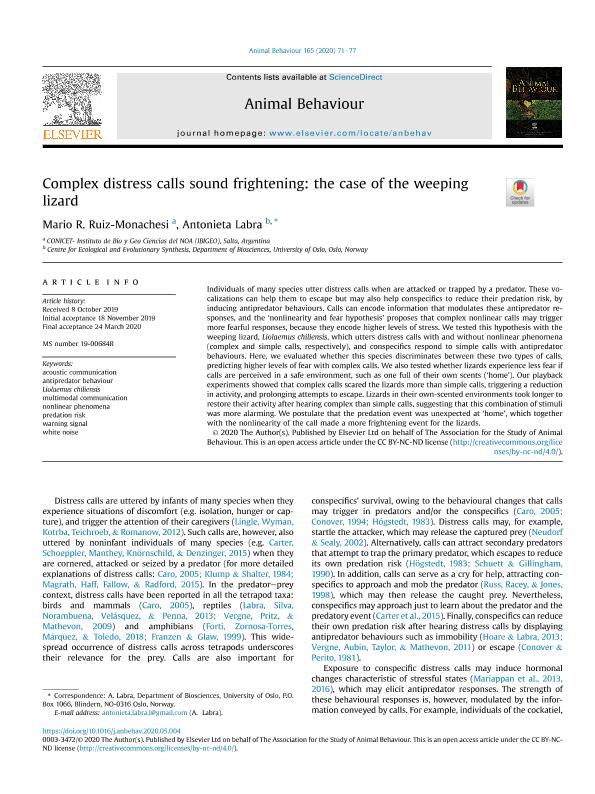Artículo
Complex distress calls sound frightening: the case of the weeping lizard
Fecha de publicación:
07/2020
Editorial:
Academic Press Ltd - Elsevier Science Ltd
Revista:
Animal Behaviour
ISSN:
0003-3472
Idioma:
Inglés
Tipo de recurso:
Artículo publicado
Clasificación temática:
Resumen
Individuals of many species utter distress calls when are attacked or trapped by a predator. These vocalizations can help them to escape but may also help conspecifics to reduce their predation risk, by inducing antipredator behaviours. Calls can encode information that modulates these antipredator responses, and the ‘nonlinearity and fear hypothesis’ proposes that complex nonlinear calls may trigger more fearful responses, because they encode higher levels of stress. We tested this hypothesis with the weeping lizard, Liolaemus chiliensis, which utters distress calls with and without nonlinear phenomena (complex and simple calls, respectively), and conspecifics respond to simple calls with antipredator behaviours. Here, we evaluated whether this species discriminates between these two types of calls, predicting higher levels of fear with complex calls. We also tested whether lizards experience less fear if calls are perceived in a safe environment, such as one full of their own scents (‘home’). Our playback experiments showed that complex calls scared the lizards more than simple calls, triggering a reduction in activity, and prolonging attempts to escape. Lizards in their own-scented environments took longer to restore their activity after hearing complex than simple calls, suggesting that this combination of stimuli was more alarming. We postulate that the predation event was unexpected at ‘home’, which together with the nonlinearity of the call made a more frightening event for the lizards.
Archivos asociados
Licencia
Identificadores
Colecciones
Articulos(IBIGEO)
Articulos de INST.DE BIO Y GEOCIENCIAS DEL NOA
Articulos de INST.DE BIO Y GEOCIENCIAS DEL NOA
Citación
Ruiz Monachesi, Mario Ricardo; Labra Lillo, Maria Antonieta; Complex distress calls sound frightening: the case of the weeping lizard; Academic Press Ltd - Elsevier Science Ltd; Animal Behaviour; 165; 7-2020; 71-77
Compartir
Altmétricas




